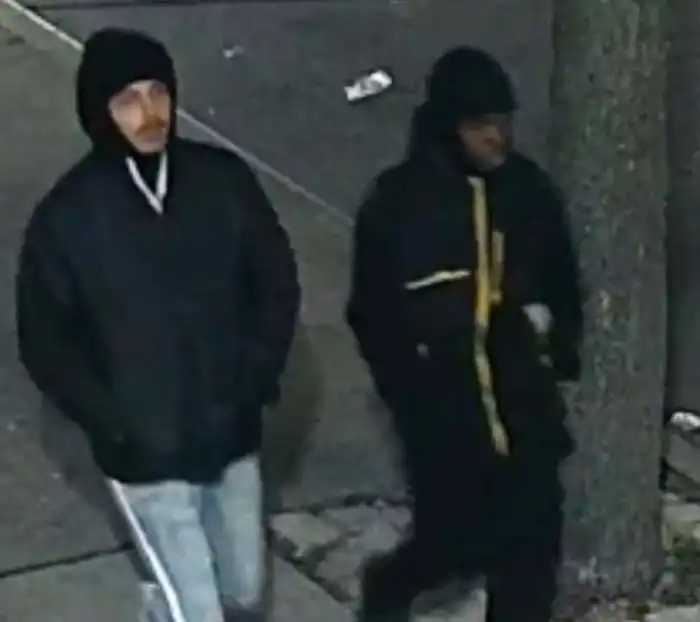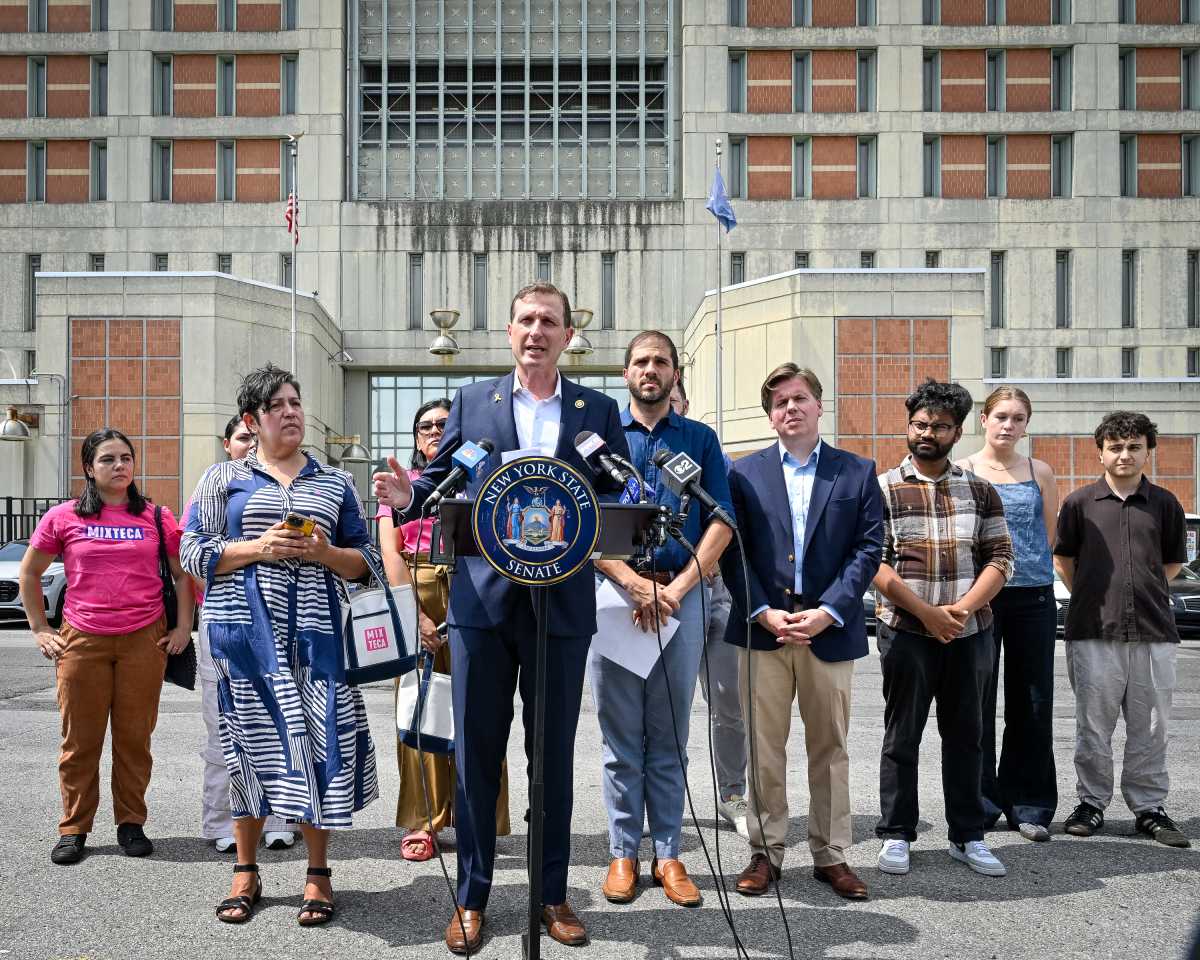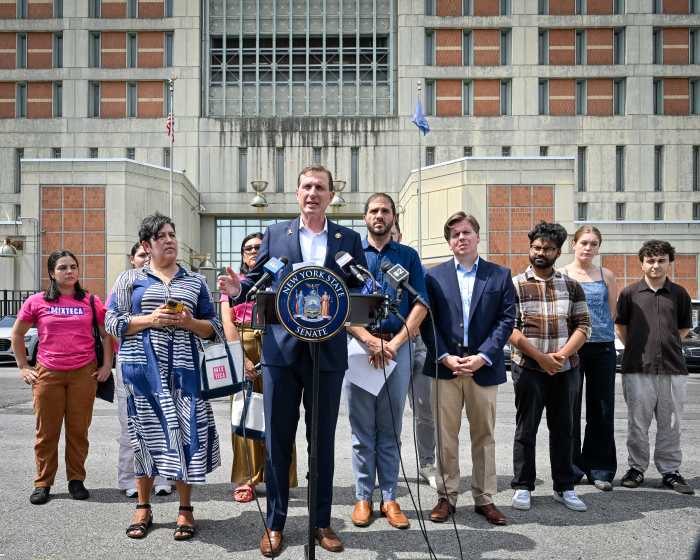By Jefferson Siegel
Hidden from sight for centuries, parts of Downtown continue to yield treasures and secrets from the city’s rich history. In 1991, just north of City Hall, workers excavating land for the Federal Building unearthed an African Burial Ground.
Last month, just after expansion work had begun on a new South Ferry subway station, a mortared stone wall was unearthed below the surface of Battery Park. The discovery brought digging to a halt so that an archaeological assessment could be conducted.
The wall, believed to be a portion of the city’s early fortifications from the late 17th century, is estimated to be at least 40 feet long and 7 feet wide. Several items found near the rampart, including two coins, helped offer a preliminary estimate of the wall’s age. A British half penny bearing the likeness of King George II bore the date 1744. Other artifacts, including a medallion believed to date to 1755, were found on top of and adjacent to the wall.
“We’re here today to announce what may be the most important archeological discovery in a New York City park in many, many years,” Parks Commissioner Adrian Benepe said last week.
Despite a host of past construction projects under Battery Park, including a highway underpass, the Brooklyn-Battery tunnel, subway tunnels, air shafts and landfills, “We were surprised by the extent of the finds,” Benepe said.
In 1624, the Dutch East-India Company established an outpost on the Battery at a time when Native-Americans inhabitated the area. Manhattan’s southernmost area was a first line of defense for the City of Niew Amsterdam, soon to become the City of New York in 1664.
In the 17th century a series of structures and fortifications were built in the area. These forts, known as “batteries,” gave rise to the area’s current name. Recalling the popular song, “New York, New York” (“The Bronx is up and the Battery’s down”), Benepe, standing several feet from a hole in which a small portion of the wall was visible, turned toward the excavation and noted, “The battery, if this is a battery, is about ten feet down. It will be of the greatest importance for us to assess what’s down there and develop a plan to salvage it and get it out of the way of the subway construction.”
Robert Tierney, chairperson of the Landmarks Preservation Commission, was no less thrilled with the discovery. “It is incredibly exciting,” he said. “Just when you think you’ve discovered everything in this city, you come across something like this,” he enthused. “It will provide yet another important element of the city’s history that you can see, touch, feel and be a part of,” Tierney added.
Bill Rudin, chairperson of the Battery Conservancy, equated the significance of unearthing the wall with the discovery of the Dead Sea Scrolls. He echoed Benepe’s suggestion that the wall would be excavated and situated above ground “so that the world can see the history of this great park and this great city.” Over the years, the private-sector Conservancy has raised tens of millions of dollars towards park rebuilding.
Warrie Price, President of the Conservancy, stood nearby holding a framed antique map of the Battery. “I purchased this map at an antique shop in New York ten years ago,” around the time she founded the Conservancy. “Understanding it (the essence of the Battery) was looking at great old maps, never dreaming it was going to be the ability to tell us something about the surface.” Price, Benepe and Tierney spent several minutes looking at the framed 1740 map as Price explained how it helped determine where the newly-unearthed wall may have originated. “I love the drawing of the half-moon Battery,” she said. Pointing to the lower portion of the map, Price noted the similarities in the area that have persevered over the centuries, adding, “It’s the same prow as we have today. It is the same curvature, it is our seawall design.”
Benepe noted that the wall might have remained hidden and buried had new station work not been undertaken. He added that, after completion of station construction, the M.T.A. will create “a village green and a bikeway that would parallel the street system” in one portion of the park. “The experts themselves are still ascertaining exactly what’s here. The stretch of wall that’s been discovered so far traverses the entire width of this construction cut,” Benepe said.
Digging continues in areas removed from the wall. “A lot of the pressure to deliver this project on a timely basis is from the Parks Department,” Commissioner Benepe added. “To get the park reopened to the public as soon as possible, we have told them, if it means delaying reopening the park to salvage this in a professional way so that it can be reused above ground, we’re okay with that.” Benepe said the transit hub, located further south from the excavation, is not in any danger of alteration or delay.
Contrary to one early report, Mysore Nagaraja, president of the M.T.A. Capital Construction Co., reassured that the wall had not suffered any damage during excavation and was in one piece.
A conservator and technicians will determine the best way to remove that portion of the wall blocking subway construction and how to raise the wall to the surface.
As of Wednesday, the Parks Department did not know when work would begin to remove the wall.
google_ad_client = “pub-6226499064891091”;
google_ad_width = 468;
google_ad_height = 60;
google_ad_format = “468x60_as”;
google_ad_channel =”0606561524″;
google_color_border = “336699”;
google_color_bg = “FFFFFF”;
google_color_link = “0000FF”;
google_color_url = “008000”;
google_color_text = “000000”;
//–>
src=”https://pagead2.googlesyndication.com/pagead/show_ads.js”>
WWW Downtown Express
































